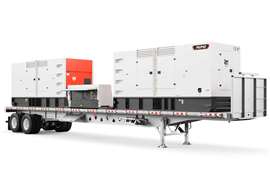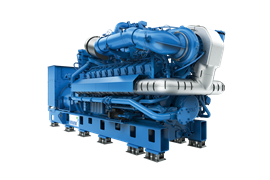Read this article in Français Deutsch Italiano Português Español
Commercial power generation presents opportunities for propane
22 April 2025
 PERC said propane can provide the flexibility and energy resilience needed for commercial applications. (Photo: Propane Education & Research Council)
PERC said propane can provide the flexibility and energy resilience needed for commercial applications. (Photo: Propane Education & Research Council)
As the director of Commercial Business Development at the Propane Education & Research Council (PERC), Bert Warner is the chief architect of the non-profit organization’s commercial portfolio, leading efforts to maximize propane awareness and gallon sales across various commercial markets. So, it’s not surprising that he sees commercial applications representing some of the greatest opportunities for propane’s growth.
“Commercial is really where the opportunity is moving forward,” he projected. “When you lose power on the commercial side, it’s not just an inconvenience like when you’re home and you lose power.” If power goes out at a business such as a restaurant, it means customers can’t be served, safety standards are compromised, food may spoil and wages are lost. “It affects revenue.”
Energy resilience is essential to mission-critical applications such as data centers and hospitals, as well. “Specifically, think of healthcare and all the backup [power] needed for systems and equipment, breathing machines, etc.,” Warner noted.
Propane can provide that resiliency in the event of a grid outage and can do so in an environmentally cleaner manner than diesel, he asserted. “There’s a lot of advantages to having propane as the energy source in traditional generators, whether they’re standby or prime power. It’s so much cleaner, so much more economical. It doesn’t need the maintenance that diesel does.”
Standard propane is also available in abundance. “We export three times as much as we use in the U.S.,” said Warner. “And so, the applications that would require it – absolutely we can fill that need. It is ever ready and available.”
Get in Early
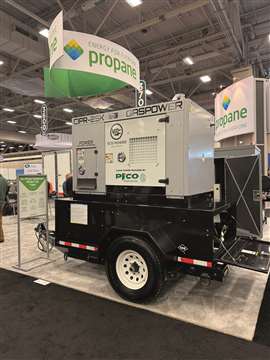 Propane can be a viable alternative for generators such as this Eco Power Equipment CIPR-25K towable model shown in the PERC PowerGen booth. (Photo: KHL Staff)
Propane can be a viable alternative for generators such as this Eco Power Equipment CIPR-25K towable model shown in the PERC PowerGen booth. (Photo: KHL Staff)
While propane is moving away from being viewed as a “backup energy” used when no other option is available to that of a “first choice energy” in certain applications, Warner said the stereotype persists that diesel is the fuel of choice for power generation. That’s why PERC urges propane proponents to get in front of design engineers on commercial projects early in the process.
“You can have... conversations with the engineers, with the specifiers that are designing [new] buildings or these retrofits, that look at propane from day one,” said Warner. “Let’s decide that on the front side because of the green aspects, the resiliency... These discussions have to be made in the early stages.
“We need to be more proactive,” he added. “Reacting to things, we’re not always great at playing a part in it. This allows us to be a ‘hero’ on the front side.”
Admittedly, there’s plenty of competition for that “hero” spot. Other gaseous fuels, biofuels and even alternative power systems are vying for position, and some appear to be winning more than others. For example, in California – once a strong alternative fuel supporter – the discussion has shifted almost entirely to electrification.
Raising Awareness
Yet, there is a silver lining. “As big as the electrification push is, and everything that has happened in California specifically, the positive is it’s brought energy awareness to a lot of peoples’ minds that maybe didn’t look at it before,” Warner said.
OEMs and their suppliers are being pressed to think beyond what they’ve historically done. “With any manufacturing, I think business as normal is not anymore,” said Warner. “They’re going to have to look to grow their business outside of traditional methods.
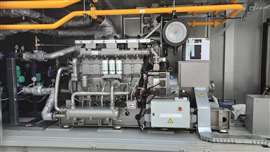 Guascor Energy’s 18 L G-18SL engine for power generation in large-scale operations. (Photo: Propane Education & Research Council)
Guascor Energy’s 18 L G-18SL engine for power generation in large-scale operations. (Photo: Propane Education & Research Council)
“What people are recognizing is we need to have energy diversification, and it needs to be done responsibly. That’s where propane can come in,” he stated. “To meet the needs of our ever-growing society, we need electrification. We need natural gas. We need propane. We need renewable propane. We need it all, and we need it in its best version.”
Economics come into play, as well, of course. “They’re not going to invest unless it’s going to be profitable for them, too. They have to have consumers who are going to buy their goods,” Warner acknowledged. “And that’s where we’re lining up to say, ‘Hey, there’s a demand for propane-powered equipment out there. You build it, there will be a place for it.’
“It’s a conversation that has to be had back and forth... an open dialogue has to happen,” he continued. “And I think from a manufacturing viewpoint, we have to make sure they see it as profitable and doable, meaning they don’t have to reinvent the wheel to get something to market.”
Fortunately, propane makes that pretty seamless. “As far as the equipment side, that’s the beauty of it. There’s no adjustment or modifications necessary,” said Warner. It’s to a point, he asserted, that if you didn’t know how it was fueled, “you wouldn’t know you were running on renewable or standard propane.”
Flexibility on Display
To showcase this flexibility, PERC invited five different OEMs and suppliers to display products in its booth at this year’s PowerGen International – all of which were capable of being fueled by propane.
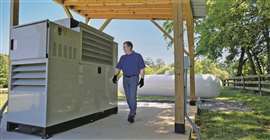 PERC launched a program to incentivize businesses to install propane-powered cooling and CHP systems. (Photo: PERC)
PERC launched a program to incentivize businesses to install propane-powered cooling and CHP systems. (Photo: PERC)
Two engines were featured: Spain-based Guascor Energy’s 18 L G-18SL engine for power generation in large-scale operations; and a propane-capable gen-set engine from Illinois-based Power Solutions International (PSI). Also on hand was the Wildcat Power Roughneck generator, and the Eco Power Equipment CIPR-25K towable generator.
A highlight was the Volt Express trailer-mounted mobile integrated electric vehicle (EV) charging and combined heat and power (CHP) system. It can fully charge light-duty commercial EVs in as little as 40 minutes, said its manufacturer Clarus, and is suitable for interim power, remote locations, special events and business continuity.
“It could be a standalone CHP unit used at a facility [but it can also] be put on a trailer and run EV charging at different events,” Warner said. If there are significant outages, it can also be used to reduce the strain on the system as the grid fires back up.
Funding Program
Beyond showing propane’s flexibility, the Volt Express EV charging and CHP system helped draw attention to PERC’s recently launched Alternative Technology Demonstration & Research Program, a funding program designed to incentivize commercial and industrial businesses to install propane-powered cooling and CHP systems for demonstration and research purposes.
Funding under the program is available for the following qualifying equipment:
- $30,000 for propane CHP units on sites greater than 15 kW
- $12,000 for propane CHP units on sites less than 15 kW
- $300/ton for propane cooling equipment ranging from light commercial (5T-25T) to heavy commercial (100T+)
Data collected from participants will help inform research about propane use, specifically in the adoption of propane cooling and CHP equipment. This will in turn be used to help educate and grow the market for these products.
“People that are benefiting the most from this are going to be [those] getting this funding,” said Warner. “And it allows us to build case studies and get tangible data that we can use in the greater promotion of the equipment and greater adoption of it.”
Renewable Propane Demand Growth
Standard propane is a byproduct of natural gas production with limited carbon output. Renewable propane, though chemically identical, is produced from biomass-based renewable feedstocks, such as vegetable oils, and generates near-zero CO2 emissions.
“People are asking for [renewable propane] because of the carbon footprint, even though propane by itself is much better than the national grid, electric national averages,” said Bert Warner, PERC. “Renewable even eclipses that to where it’s incredibly efficient decarbonization energy.”
But while there are multiple ways to produce it, renewable propane production is currently limited; the industry is still ramping up and simply can’t produce it fast enough to meet growing demand. Cost of production is also a factor.
“We need more of it,” said Warner. “Right now, the majority of the renewable propane is going to the auto sector because of tax credits that are involved, and that’s great. But we’re seeing a demand for it outside of that into the commercial spaces, into the ag spaces, into these other spaces where it can be used.”
So, while the growth opportunity is substantial, production capacity remains a limiting factor. “Obviously, it’s a supply and demand thing,” said Warner. “The more people that want it, the more we can build it.”
Editor’s note: this story originally appeared in the April 2025 issue of Power Progress.
POWER SOURCING GUIDE
The trusted reference and buyer’s guide for 83 years
The original “desktop search engine,” guiding nearly 10,000 users in more than 90 countries it is the primary reference for specifications and details on all the components that go into engine systems.
Visit Now
STAY CONNECTED




Receive the information you need when you need it through our world-leading magazines, newsletters and daily briefings.
CONNECT WITH THE TEAM











